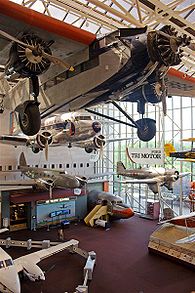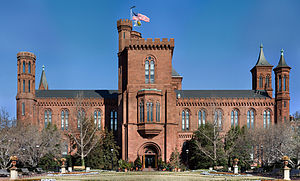Smithsonian Institution
http://en.wikipedia.org/wiki/Smithsonian_Institution
Smithsonian National Museum of Natural History
The Elliott kids have been meaning to visit the National Museum of Natural History ever since Night at the Museum: Battle of the Smithsonian hit the theaters. We finally made it and we were not let down. Highlights included T-Rex and the dinosaur bones, the Hope diamond and mineral displays as well as the “zoo.”
The “Castle” (1847), the Institution’s first building and still its headquarters
The Smithsonian Institution (![]() /smɪθˈsoʊniən/ smith-soh-nee-ən), established 1846 “for the increase and diffusion of knowledge”, is a group of museums and research centers administered by the United States government. Termed “the nation’s attic” for its eclectic holdings of 137 million items, the Institution’s Washington, D.C. nucleus of nineteen museums, nine research centers, and zoo—many of them historical or architectural landmarks—is the largest such complex in the world. Additional facilities are located in Arizona, Maryland, New York City, Virginia, Panama and elsewhere, and 168 other museums are Smithsonian affiliates. The Institutions’s thirty million annual visitors are admitted without charge; funding comes from the Institution’s own endowment, private and corporate contributions, membership dues, government support, and retail, concession and licensing revenues. Institution publications include Smithsonian and Air & Space magazines.
/smɪθˈsoʊniən/ smith-soh-nee-ən), established 1846 “for the increase and diffusion of knowledge”, is a group of museums and research centers administered by the United States government. Termed “the nation’s attic” for its eclectic holdings of 137 million items, the Institution’s Washington, D.C. nucleus of nineteen museums, nine research centers, and zoo—many of them historical or architectural landmarks—is the largest such complex in the world. Additional facilities are located in Arizona, Maryland, New York City, Virginia, Panama and elsewhere, and 168 other museums are Smithsonian affiliates. The Institutions’s thirty million annual visitors are admitted without charge; funding comes from the Institution’s own endowment, private and corporate contributions, membership dues, government support, and retail, concession and licensing revenues. Institution publications include Smithsonian and Air & Space magazines.
Founding
British scientist James Smithson (d. 1829) left most of his wealth to a nephew, but when the nephew died childless in 1835, under Smithson’s will the estate passed “to the United States of America, to found at Washington, under the name of the Smithsonian Institution, an Establishment for the increase & diffusion of knowledge among men.” Richard Rush was dispatched to England to collect the bequest, returning some two years later with 104,960 gold sovereigns (about $500,000 at the time).
Unfortunatey the money was invested in bonds which soon defaulted. After heated debate Massachusetts Representative (and ex-President) John Quincy Adams persuaded Congress to restore the lost funds with interest and, despite designs on the money for other purposes, convinced his colleagues to preserve it for an institution of science and learning. After debate on whether the federal government had the authority to accept such a gift, Congress accepted the legacy and pledged the faith of the United States to the charitable trust on July 1, 1836.
Early Development
The Smithsonian Institution, established 1846 “for the increase and diffusion of knowledge,” is a group of museums and research centers administered by the United States government.
Though the Smithsonian’s first Secretary, Joseph Henry, wanted the Institution to be a center for scientific research, before long it also became the depository for various Washington and U.S. government collections. The United States Exploring Expedition by the U.S. Navy circumnavigated the globe between 1838 and 1842. The voyage amassed thousands of animal specimens, an herbariumof 50,000 plant specimens, and diverse shells and minerals, tropical birds, jars of seawater, and ethnographic artifacts from the South Pacific. These specimens and artifacts became part of the Smithsonian collections, as did those collected by several military and civilian surveys of the American West, including the Mexican Boundary Survey and Pacific Railroad Surveys, which assembled many Native American artifacts and natural history specimens.When the Detroit philanthropist Charles Lang Freer donated his private collection to the Smithsonian and funds to build the museum to hold it (which was named the Freer Gallery), it was among the Smithsonian’s first major donations from a private individual. The gallery opened in 1923.
The Institution became a magnet for natural scientists from 1857 to 1866, who formed a group called the Megatherium Club. Many scientists of a variety of disciplines work at the various Smithsonian museums, which have become centers for research.
Museums – Main article: List of Smithsonian museums
 Aircraft on display at the National Air and Space Museum, including a Ford Trimotor and Douglas DC-3 (top and second from top).
Aircraft on display at the National Air and Space Museum, including a Ford Trimotor and Douglas DC-3 (top and second from top).
Nineteen museums and galleries, as well as the National Zoological Park, comprise the Smithsonian museums. Eleven are on the National Mall, the strip of land that runs between the Lincoln Memorial and the United States Capitol. Other museums are located elsewhere in Washington, D.C., with two more in New York City and one in Chantilly, Virginia.
The Smithsonian has close ties with 168 other museums in 39 states, Panama and Puerto Rico. These museums are known as Smithsonian Affiliated museums. Collections of artifacts are given to these museums in the form of long-term loans. The Smithsonian also has a large number of traveling exhibitions. In 2008, 58 of these traveling exhibitions went to 510 venues across the country.



